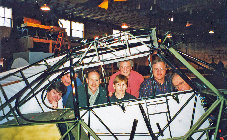building process for bringing intimacy between the builder and project. Building can also result in a new aircraft with
better flight characteristics than anything on the market. Even an old aircraft can become a better-than-new aircraft often
improved and stronger than the plane that rolled out of the factory. But building has its downside. Building or restoring
an aircraft can take hundreds, if not thousands, of hours often for many years. It is a big commitment. The complexity
of a restoration is many times the difficulty of my other projects. (It is the scope and length of a project that results in
defeat and giving up by so many. So take on a project with foresight and commitment.) But the question I could not honestly
answer for myself was, could I do it? The Experimental Aircraft Association (EAA) is living proof that people can and do build
and restore aircraft. But I had never done it.
Ted's Aircraft Shop
Step 1. Picking a Project, page, page 2
Step 1. Picking a Project
I have been a member of the EAA since 1984 and have made the annual pilgrimage to the annual EAA AirVenture at Oshkosh, Wisconsin,
at the End of July for nearly 20 years while living in Chicago. What I saw told me I had enough skills to get started and I
could learn anything else I needed. In 1999, I took two week-long courses on aircraft restoration at the EAA Air Academy on
the grounds of the Pioneer Airport and EAA Museum in Oshkosh, Wisconsin. In week one, I learned the fabrication of
wood ribs, aluminum sheet bending and riveting, welding of 4130 steel tubing, and fabric covering with ceconite. The second
week focused on fabric covering of a steel tube and fabric aircraft and spray painting. Working through the various processes
and seeing these processes applied to aircraft in the EAA museum shops convinced me a restoration project was workable. Thrilled
and excited beyond belief, I came home determined to get started as soon as I could find a project.
Looking through Trade-A-Plane and Barnstormers on the web, I realized after a couple of months that there are always projects for
sale. A rough judgment tells me that projects cost about half of what a flying aircraft costs. I quickly focused on the
Piper Cub J-3. There are many of them out there, flying and projects. There is a large community of people who restore
and maintain them, and the “type” club is a rich lode of information. I found a 1946 J-3 project for sale in Bonita Springs,
Florida, complete except for engine.

10. Covering the Fuselage
11. Assembling and Rigging
12. Flight Testing